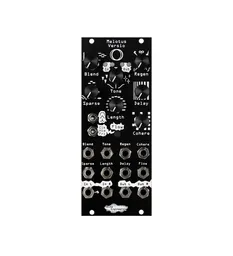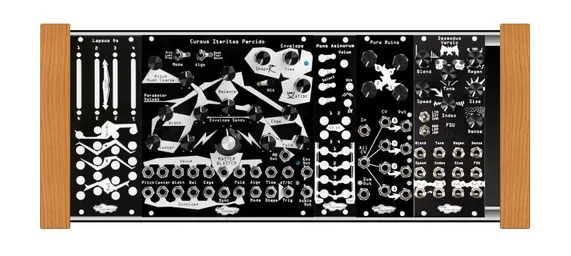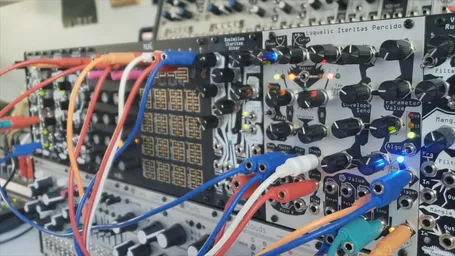4 out of 5 succulents agree: ambient is awesome. And with the recent release of Desmodus Versio, our reverb/DSP platform, it seemed like a good time to talk about making ambient patches with an all-NE setup or two. Let’s go!
What we need in an ambient-oriented Eurorack system
Ambient systems can go a lot of different ways. Like, seriously, a LOT. We’re just barely scratching the surface here, so feel free to get creative with your module choices when you’re building out your ambient system. For most systems, though, there are a few key components we’ll want to have.
Sound source(s)
Let’s start at the beginning here. There are many many choices for your sound source, or sources, in an ambient system: some people like oscillators, some people like granular units or samplers like the QuBit Nebulae or Make Noise Morphagene, some people use filters or resonators (check out this post to learn about how a filter can work as a sound source), and many people use a combination of sources. Our choice of sound source is important, as it’ll be the backbone of all our patches. Today, I’ll be using voices from the NE lineup (big shock, I know), but you can sub in whatever you have.
Sequencing and modulation
Having a sound source is all well and good, but how do we make it do something interesting? Modulation! Slow LFOs are a personal favorite for anything like this, as they can be multed out to lots of destinations to create some slow movement throughout a whole patch. We can also use something like Clep Diaz, which has an LFO mode that gives random smooth movement. Or, we can use a step sequencer like Mimetic Digitalis or Mimetic Sequent to create some movement. Lots of options!
Processing
We’ll definitely want some modules to spice up our sounds. You may be thinking of ambient as all pretty clouds and rainbows, but you can really use anything here: as you’ll see later on we can make some pretty awesome use of distortion in an ambient patch. Effects that create an atmosphere and space are pretty common in ambient patches, though, so we’ll have Desmodus Versio in there for sure.
Learn more:
Control
In almost any patch it’s great to get hands-on with certain elements and play them on the fly. Lapsus Os is a great choice for this, as it offers a simple control surface that can be used to send modulation into a patch, adjust multiple parameters at once, or modify other CV. There are many types of modules you could use for this too, as well as external controllers: maybe you want to play in some melodies with a keyboard, for instance. (I know I do!)
Making an actual system
Let’s tie all this together and make a system (or two)! I came up with a few concepts, but after playing with some patches, this one blew me away. It’s unusual, I know, but trust me, it can do some amazing things.

Let’s talk about our choices here. First, we have the aforementioned Lapsus Os, which we’ll mainly use to attenuate LFOs from Pons Asinorum. We have our voice, Cursus Iteritas Percido, which is a great voice for this sort of thing. We don’t have any trigger sequencing in this system, but that’s okay: CIP can loop its internal envelope or it can bypass its output VCA and drone by itself. We have that Pons Asinorum, which will end up being four very slow triangle LFOs. We have Pura Ruina -- an unusual choice, but one that complements the CIP in a chaotically beautiful kind of way. The levels of the four stages of PR will be modulated by Pons Asinorum, and we can bring in that modulation individually with Lapsus Os. And finally, we have Desmodus Versio, which gives us a beautiful reverb to put our resulting sounds into. Let’s hear what this can sound like.
Now, the first time I patched this system together, I had a WHOA moment. This is a pretty simple patch, but it gives a LOT of flexibility, and a surprising amount of pseudo-melodic complexity thanks to the nature of CIP’s tone generation and PR’s characteristics. And there’s so much to play with: even outside of our four LO channels, Pons Asinorum’s encoder is surprisingly jammable, and it changes the character of the patch in a big way at the twist of a knob. Combined with the Master Blaster on CIP and that inviting FSU button on DV, this patch is a lot of fun to play.
But wait, what’s that other case over there??
Selected Ambient Modules Vol. 2
Let’s look at another system.

This one has two voices, and some quantized sequencing, which will open up some new possibilities. But wait, there’s no mixer! Where will our voices go?
Here’s the thing about DV: it’s a stereo-in, stereo-out reverb, but the way it processes sounds is more complicated than a dual mono device (which is what a lot of stereo things are). Imagine you’re standing in a big, echoey room. If there’s a sound coming from your left and a sound coming from your right, you’ll hear them to your sides initially, but you’ll also hear their echoes all around you. That's basically what DV does! If we patch our two voices to the L and R In jacks, we’ll get an amazing stereo space with no mixer required.
The sequencing is where this case gets interesting, though: we have Mimetic Digitalis, which I’ll use to modulate the MI and BIA, and the Mimetic Sequent and its expander, which I’ll use to generate random triggers and melodies for those voices. While the MS is often thought of as a CV recorder, it can generate random CV on its own, and that CV can be quantized internally. The expander’s 3 CV outs let us use all 3 patterns in MS at the same time, so we can generate a melodic pattern, copy it to our other voice, modify it, modify the original… There’s a lot of options.
Mimetic Digitalis has a few ways to move its steps around, but I can also just use a trigger out from Mimetic Multium and move it randomly, changing our voice’s tone every once in a while.
The astute reader may have noticed that we don’t have a clock in our system, and the even more astute reader may know that we can use Pons Asinorum as a clock! I’ve been doing this a lot recently because it’s a great way to get a very simple voltage-controlled clock. I’ve used one looping channel of PA as our clock, and I’m using another much slower looping channel to modulate the frequency of that clock. This gives us a gradual tempo change that builds tension throughout the whole patch.
And lastly, we have Sinc Defero: it’s a quad attenuator and mult, which I’ll use to attenuate the other two channels of Pons Asinorum and modulate the DV. Let’s take a listen.
This is a much more involved patch, but it’s still quite performable, with more focus on sequencing than last time - we mostly stuck to controlling our tone there.
Remember, all these ideas can be adapted to other modules. Swapping things in that serve a similar function but do it differently will make your patch unique. Maybe you want a different control surface? Replace Lapsus Os with a Tetrapad or a Pressure Points. Want a different flavor of effect? Grab a Rainmaker or a Clouds. There’s no wrong way to patch!






